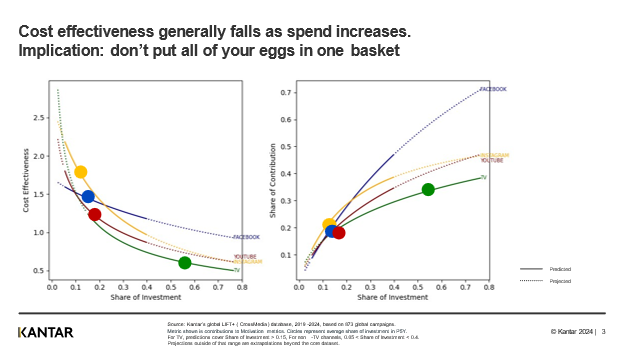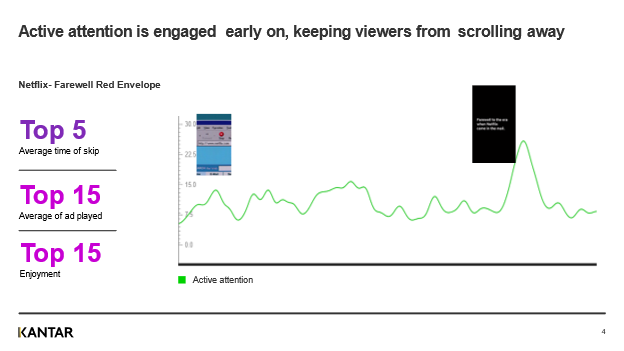Thanks to the work of many researchers and industry efforts such as the I-COM attention forum and the ARF validation initiative, our collective understanding of attention’s role in building brands has improved significantly since I wrote that the Attention Economy has landed after Cannes Lions in 2022. Attention learning is now much more comprehensive, nuanced and layered. We don’t just understand that attention generally matters, we also understand when and how that simple relationship can fall down, and how individual brands can maximise meaningful attention. So let’s review the latest evidence and insights into how brands can take their campaigns from playback to payback.
Where can you capture enough attention to grow your brand?
In an Attention Economy, every second counts and attention measurement is adding fresh insight into how ads work. At Kantar we are well aligned with the ARF’s ad response model which says that attention is the gateway to ad effectiveness. We are strong believers that brands should not be measuring or optimising attention in isolation. That’s why the Kantar definition of branded engagement bridges from delivery through attention and into effects. We believe it’s important to understand how much of your delivery will be noticed, and whether your brand is noticed while people are paying attention. Beyond that, it's obviously also key to deliver some fresh associations which will make people more predisposed to buy your brand in the short and long-term.

So, we believe attention matters, and we’ve also validated that more creative attention generally drives stronger outcomes. By mapping creative attention scores to short-term sales shifts, we’ve learned that active attention (some kind of emotional response) is more important than passive visual attention (just watching). But what you do with that attention matters much more. If your ad isn’t well branded, and doesn’t deliver a persuasive message, then it won’t drive sales.
Given attention generally drives better outcomes, there’s been a lot of discussion about whether brands should now be optimizing their media plans entirely towards what are considered to be high attention media placements. Unfortunately, it’s not quite as simple as that. Channel attention levels per impression do not seem to be directly related to channel-level campaign cost-effectiveness.
Let’s look at the latest learning about which channels build brands from Kantar’s global LIFT+ database of cross media effectiveness. In the chart below, the overall contributions are shown on the x axis, and the relative cost-effectiveness of those channels is displayed on the y axis. This dataset covers 873 multi-media campaigns we have monitored around the world during the past 5 years, representing over $3.2 billion in media spend.
As you can see, TV has the highest overall contributions to brand metrics, but it has much lower cost effectiveness, despite being generally acknowledged to be a high attention medium per impression. Cinema is generally understood to have very high attention levels per impression, but has less cost-effective contributions to brand. In contrast, all of the digital channels manage to build brands more cost-effectively despite tending to have relatively low attention levels. So how can this possibly make sense? Let’s explore the results in a bit more detail.

Firstly, let's drill down into what is driving overall brand cost effectiveness. Cost effectiveness is a combination of the impact we see in all kinds of different brand measures. Meta is 66% more cost effective overall at building brands compared to an average channel, and it is particularly strong at building brand predisposition. Meta delivers 88% stronger returns than an average channel on short-term purchase intent and longer-term meaningful difference. In contrast, while TV isn’t very cost-effective overall (41% less cost effective than an average channel), it is slightly more effective for upper funnel awareness and brand associations.
So why do we see such low cost effectiveness for TV in particular? The main reason is that it hoovers up an incredibly large share of investment for many Kantar clients. Every channel we measure sees effectiveness fall for higher shares of spend, even as absolute brand contributions increase. Over-spend is most common with TV where Kantar clients are still spending an average of just over 50% of their total media investment. Digital channels such YouTube, Facebook and Instagram are each still more likely to be seeing less than 20% of spend. The key implication from this is not to put all of your eggs in one basket. Media spend which is more evenly distributed across different channels will generally work better. And within individual channels, we also know that more formats generally work better too.

Why is the relationship between attention and cost effectiveness complicated?
The relationship between attention and brand-building cost effectiveness is not a simple one. There are many reasons that we don’t see a direct relationship between attention and cost effectiveness. Here are just some of them. For a start, not every second of attention costs the same. There’s no point having 20% more attention if you are paying 50% more for the privilege. As we've seen earlier there's also a big difference between passive attention (just watching) and active attention which is where the interesting emotional response happens, and there is surprisingly little correlation between the two measures at an ad-level. Some brands need a lot of attention for their ads to be cost effective, but others really don’t, and then even within one campaign you may just have a few longer, hero assets that need high attention, but that doesn't mean that your entire campaign needs to be high attention placements. As well as how long people are paying attention, you've got to consider the person who's paying attention. If the audience targeting is more precise in some environments that's obviously also going to make a big difference to the cost effectiveness of the spend.
Additionally, not every second of attention is created equal or will deliver the same level of return. Drilling into this idea further, Dentsu research published by WARC says that short-form video is more "attentionally efficient". That’s because they observed higher recall and impact on purchase intent for the same number of seconds within a short ad vs the same amount of attention in longer ads. The neuroscience learnings popularised by Daniel Kahneman help explain this. The duration neglect principle says that how long you experience something doesn’t necessarily impact your overall memory of that experience. This isn‘t to say that more attention isn‘t generally a good thing, but you can have a surprisingly large amount of brand impact in a relatively short amount of time.
How can you maximise attention with amazing creative?
Let's move now from where you can find attention for your ads, to a few examples of how you can maximise attention within those placements with amazing creative.
This 15 second Facebook video for Kahlua was the best digital ad in this year’s Kantar Creative Effectiveness Awards, based on its ability to drive short-term sales as well as long-term equity. ‘Gasp featuring Salma Hayek’ is a bold example of how to really grab attention, and in doing so, immediately start building consumer connections.
Another way to optimise your creative return on attention is to maximise your distinctive brand assets.
Timberland’s "This is not a boot" Instagram ad grabbed the third winning spot in the Digital/Social category in the Kantar Creative Effectiveness Awards this year. It focuses boldly on the product, showing colourful boots raining down over the text "this is not a boot," paying homage to surrealism and evoking a great sense of a brand having full confidence in the product. Many viewers likely would stick with it for the full 30 seconds, but even those who don’t will have taken away some strong and powerful brand associations.

Finally, let’s look at an even longer Instagram video from Netflix, which retains attention via emotional engagement. The recent "farewell" ad focuses on the journey of the ‘red envelope’, a distinctive brand asset of Netflix, and is placed among the very top performers from the USA in our ad testing database. The ad manages to reach a high viewability level compared to what we’d expect from an ad of this length. Viewers are engaged with the nostalgic spot from early on, and the dynamic emotional engagement remains as viewers continue watching.

Kantar’s Attention Framework embraces facial coding with eye tracking as a great way to observe and diagnose attention at scale. The framework covering playback, passive attention, active attention and emotional diagnosis is well aligned with the most common and appropriate industry metric definitions identified with the ARF’s attention validation initiative.
How can attention insight can drive media and creative effectiveness?
From a media point of view, brands should optimise for effectiveness, knowing that attention optimisation may help with that. A balanced channel mix and a balanced mix of attention levels is usually best. Digital channels generally build brands most cost-effectively. Brands should understand their own attention threshold and plan for that, rather than just applying a simplistic general rule.
From a creative perspective it is important to tailor your structure and narrative to channel and context. Brands should prioritise active rather than passive attention, but ultimately optimise for outcomes. It’s important to build on brilliant basics with what works for your brand and your distinctive brand assets.
From a measurement perspective, attention should be used as a complement to existing KPIs, not as a replacement. You have most to gain by scaling attention insight focused on the intersection of creative and media. Facial coding with eye tracking is the best way to observe and diagnose attention, while AI techniques are now helping to scale that insight.
Get in touch find out more about the Kantar media and creative effectiveness products behind this research.
Note: this article has been edited since the original publication.

